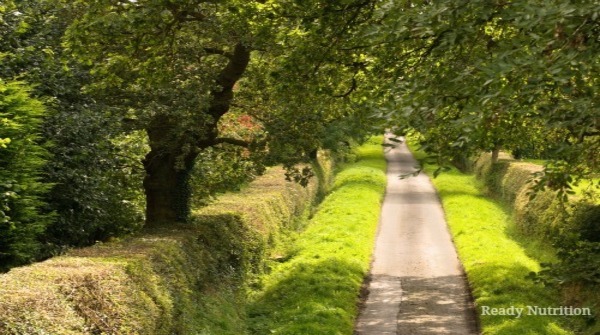Hedgerows have been around for centuries and date back as early as the Bronze Age (3000 B.C – -1000 B.C.). Once used as a means to delineate property lines and to provide windbreaks and prevent soil erosion, they are fading from modern agriculture and homesteading. They have many benefits beyond the aesthetic, though, and are an excellent long-term planting for homesteads. In Great Britain, the word “hedge” is a name derived from the hawthorn: a thorn tree used as a weapon of defense. Today in the United States, we are most familiar with the privet hedge- a common, neatly trimmed landscaping bush in urban yards that is usually in a box or rectangular shape. But a hedge can be so much more than that.
For the homesteader, a hedgerow can provide multiple benefits. A traditional Saxon hedgerow, comprised of thorny hawthorns and other native species, makes an excellent “hidden prep” as a dense, thorny barrier that blends in well with the land. Hedgerows also provide a wind break to help reduce soil erosion, provides surface water filtration, reduces water evaporation in garden soil and seedlings, and improve air quality. It provides over-wintering grounds that attracts birds and beneficial insects and an early spring food supply for pollinators. Small food animals like rabbits find a home in the dense undergrowth.
Depending on the types of plants you choose to include in your hedgerow, it can also provide kindling wood, medicinal herbs, edible berries, nuts, and other fruits. If you have an organic homestead, a hedgerow on the borders of your gardens can conceal or hide it from view or property can even provide a buffer from pesticide drift from your neighbors that grow crops conventionally. A mature, established hedgerow that borders crop areas can also help reduce invasive weedy annuals. The root structures of the established hedgerow perennials out-compete the annuals for food, light, and water and provide a barrier to wind-blown seeds.
There are several types of hedgerows that can be constructed and care should be taken to select the type that works best for your climate, soil, and the purpose of the hedge. This should also be seen as a long-term project if you intend to construct a live hedge and it could take three to five years of care and watering to establish. Once established, though, a hedge takes on the life and ecosystem of its own and requires very little financial input or physical care.
Dead Hedge
The simplest and oldest type of hedgerows was known by the Saxons as a “dead” hedge. Very simple to make and crude in appearance, it can be made by sticking cut branches into the ground and interweaving them with other limber, green branches to create a wall that looks very much like the side wall of a basket or like modern sheep hurdles. This hedge requires yearly maintenance and is the least effective in terms of both providing habitat and defense.
Although they don’t provide the diversity and habitat that live hedges provide, dead hedges and sheep hurdles have their place on the homestead. They’re an excellent use of natural resources if you’re lucky enough to have a woodlot on your property. They are also completely self-sufficient in that they require no other materials than what can be found in nature. They’re commonly used to enclose animals in somewhat temporary fencing or to provide a privacy screen around patios or other personal space areas close to the home. An excellent video on how to make a sheep hurdle can be found here.
Privet Hedge
The second type of hedgerow is the one seen most commonly seen in urban landscaping- the privet hedge. Formal and stately, this type of hedge was very popular about fifty years ago, but can still be seen in many yards today. It provides privacy, some measure of noise reduction, and is somewhat difficult to penetrate. The most commonly used plant for this hedge is in the genus Ligustrum, which contains over fifty species. These plants are fast growing, take readily to any shape you’d like to trim them into, and do well in poor soils. However, they aren’t native to the United States, can become invasive, and are highly allergenic (rating 9 out of 10 on the Ogren Plant Allergy Scale).
Some species, like the Chinese privet, have been used in traditional medicines. Others, however, can be quite toxic. As always, be extremely cautious when ingesting any plant unless you know exactly what you’re dealing with! Privets can tolerate sun, heat, and drought, but will develop root rot from wet or heavy soils or over-watering. This mono-culture hedge requires yearly maintenance to preserve its shape and density and because it’s comprised of a single species of plant, doesn’t offer the multi-culture diversity of a traditional Saxon hedgerow. An example of a privet hedge can be seen here.
The Saxon Hedge is a thing to behold. Carefully crafted, the inter-twining branches offer a formidable barrier to human and livestock alike (although, I’m pretty sure goats would try their best to eat their way through it). Inspiration Green has excellent step-by-step instructions on how to lay a hedge and what it should look like at various stages. It can be found here.
There’s no need to limit yourself to the natives of Europe if you’re in the United States, though. Hawthorn species native to the United States can be found here. Not only will you get the added benefit of a native plant that has evolved for it’s climate, you’re also more likely to attract native species of pollinators and birds that will use it as a source of food and shelter. Insect-eating birds can be especially important to an organic garden!
Saxon hedges often also contain nut or full-sized fruit trees along the hedge line. Be sure to plant these when you originally plant the hawthorns or whichever plant you choose to create your hedge. The hedge then gets laid and twined around the fruit or nut trees and the trunks of the trees become incorporated into the hedge to further strengthen it. Depending on your climate, you may also want to consider planting herbs along and inter-mixed with your hedgerow plants. Keep in mind that once your hedge has matured, it will cast a shadow on one side more than the other depending on its location and how the sun tracks across it. For perennials, like sage or rosemary, you’ll want to choose the side of the hedge that gets the most sun.
Add Defense Measures to Your Perimeter
Another consideration is to incorporate physical anti-ram vehicles barricades into the hedge line. It will take some time before they’re completely concealed by the growth of the hedge, but with careful weaving, the barriers become nearly invisible to the casual observer. A hidden prep is one of the best defenses- it incorporates an element of surprise towards whomever would do you harm.
Hedges add beauty, function, and value to your property. They’re an excellent way to create borders and contain livestock using natural resources and can provide habitat to wildlife, a screen from pesticide drift, and control soil erosion. Learning how to plant, build, and tend a hedge is a valuable skill to learn whether you’re a homesteader wanting to rely less on man-made materials or a prepper looking to add a hidden prep.
Ruby is a first generation Californian who grew up in the heart of the Central San Joaquin Valley farming community. She’s been involved in agriculture for 40 years and learned to preserve food, traditional home arts, to hunt and fish, raise livestock and garden from her Ozark native mother.





